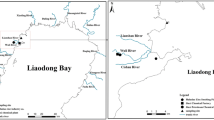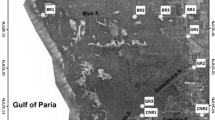Abstract
Marine debris and trace metals are among the common environmental contaminants known to affect marine organisms. In this study, the quantitative and qualitative aspects of marine debris levels and bioaccumulation of trace metals (Cadmium: Cd; Copper: Cu; Lead: Pb; and Zinc: Zn) were investigated in 42 green sea turtles (Chelonia mydas) stranded on the northern coast of the Sea of Oman. The greatest quantity of debris was found in the intestine, stomach, and esophagus of the animals, respectively. Results of a Marine Strategy Framework Directive (MSFD) subcategory analysis of the ingested debris showed that sheet and thread-like plastics were the most frequently detected debris followed by various rubbish. The results revealed that white-colored debris were the most common debris, followed by black > green > blue > transparent > and brown ones. The results suggested that the rope monofilament was the main source of the ingested debris by the green sea turtles. Concentrations of the trace metals in the liver, kidney, and muscle ranged between 0.66–33.43, 0.36–15.12, and 0.33–7.47 μg/g (ww), respectively. The results of this study suggest that ingested marine debris and tissue concentrations of trace metals are present at levels that may cause sublethal effects on green sea turtles (C. mydas) through potentially affecting the physiological processes and making the turtles susceptible to other natural or human threats. Results indicated that the green sea turtles from the northern coast of the Sea of Oman have high interaction with the marine debris. These factors are considered as a serious threat to the existence and survival of the green sea turtles (C. mydas) living on the northern coast of the Sea of Oman.


Similar content being viewed by others
Availability of data and material
Not applicable.
Code availability
Not applicable.
References
Agamuthu P, Mehran SB, Norkhairah A, Norkhairiyah A (2019) Marine debris: a review of impacts and global initiatives. Waste Manag Res 37(10):987–1002
Askari Hesni M, Tabib M, Hadi Ramaki A (2015) Nesting ecology and reproductive biology of the hawksbill turtle, Eretmochelys imbricata, at Kish Island, Persian Sea. J Mar Biol Assoc United Kingdom 96(7):1373–1378
Awabdi DR, Siciliano S, Di Beneditto APM (2013) Ingestão de resíduos sólidos por tartarugas-verdes juvenis, Chelonia mydas (Linnaeus, 1758), na costa leste do estado do Rio de Janeiro, Brasil. Biotemas 26:197–200
Campani T, Baini M, Giannetti M, Cancelli F, Mancusi C, Serena F, Marsili L, Casini S, Fossi MC (2013) Presence of plastic debris in loggerhead turtle stranded along the Tuscany coasts of the Pelagos Sanctuary for Mediterranean Marine Mammals (Italy). Mar Pollut Bull 74:1330–1334
Carman V, Marcelo M, Maxwell S, Albareda D, Campagna C, Mianzan H (2013) Young green turtles, Chelonia mydas, exposed to plastic in a frontal area of the SW Atlantic. Mar Pollut Bull 78(10):56–62
Carvalho RH, Lacerda PD, da Silva MS, Barbosa BC, Paschoalini M, Prezoto F, de Sousa BM (2015) Marine debris ingestion by sea turtles (Testudines) on the Brazilian coast: an underestimated threat? Mar Pollut Bull 101:746–749
Casale P, Abbate G, Freggi D, Conte N, Oliverio M, Argano R (2008) Foraging ecology of loggerhead sea turtles Caretta in the central Mediterranean Sea: evidence for a relaxed life history model. Mar Ecol Prog Ser 372:265–276
Colferai A, Pinho Silva-Filho R, Moreira A, Bugoni L (2017) Distribution pattern of anthropogenic marine debris along the gastrointestinal tract of green turtles (Chelonia mydas) as implications for rehabilitation. Mar Pollut Bull 119:231–243
Day RD, Christopher SJ, Becker PR, Whitaker DW (2005) Monitoring mercury in the loggerhead sea turtle, Caretta caretta. Environ Sci Technol 39:437–446
Eastman CB, Farrell JA, Whitmore L, Rollinson Ramia DR, Thomas RS, Prine J, Eastman SF, Osborne TZ, Martindale MQ, Duffy DJ (2020) Plastic ingestion in post-hatchling sea turtles: assessing a major threat in Florida near shore waters. Front Mar Sci 7:693
Ehsanpour M, Afkhami M, Khoshnood R, Reich KJ (2014) determination and maternal transfer of trace metals (Cd, Cu Zn, Pb and Hg) in the hawksbill sea turtle (Eretmochelys imbricata) from a nesting colony of Qeshm Island, Iran. Bull Environ Contam Toxicol. https://doi.org/10.1007/s00128-014-1244-3.
Ferreira MBMS, Garcia M, Jupp BP, Al-Kilyumi A (2006) Diet of the green turtle (Chelonia mydas) at Ra’s Al Hadd, Sultanate of Oman. Chelonian Conserv Biol 5:141–146
Foley AM, Singel K, Dutton P, Summers T, Redlow A, Lessman J (2007) Characteristics of a green turtle (Chelonia mydas) assemblage in northwestern Florida determined during a hypothermic stunning event. Sea Mex Sci 25:131–143
Frick MG, Williams KL, Bolten AB, Bjorndal KA, Martins HR (2009) Foraging ecology of oceanic-stage loggerhead sea turtles Caretta caretta. Endanger Species Res 9:91–97
Galgani F, Hanke G, Werner S, Vrees DL, Piha H, Abaza V, Alcaro L, Belchior C, Brooks C, Budziak A, Carroll C, Christiansen T, Dagevos J, Detloff K, Fleet D, Hagebro C, Holdsworth NKG, Katsanevakis S, Wenneker B (2011) Marine litter technical recommendations for the implementation of MSFD requirements, MSFD GES technical subgroup on marine litter. Luxembourg. https://doi.org/10.2788/92438.
Guebert-Bartholo FM, Barletta M, Costa MF, Monteiro-Filho ELA (2011) Using gut contents to assess foraging patterns of juvenile green turtles Chelonia mydas in the Paranaguá Estuary. Brazil Endanger Species Res 13:131–143
Guirlet E, Das K, Girondot M (2008) Maternal transfer of trace elements in leatherback turtles (Dermochelys coriacea) of French Guiana. Aqua Toxicol 88:267–276
Kampalath R, Gardner SC, Mendèz-Rodríguez L, Jay JA (2006) Total and methylmercury in three species of sea turtles of Baja California Sur. Mar Pollut Bull 52:1784–1832
Lazar B, Gračan R (2011) Ingestion of marine debris by loggerhead sea turtles, Caretta caretta, in the Adriatic Sea. Mar Pollut Bull 62:43–47
Macedo GR, Pires TT, Rostán G, Goldberg DW, Leal DC, Garcez-Neto AF, Franke CR (2011) Ingestão de resíduos antropogênicos por tartarugas marinhas no litoral norte do estado da Bahia, Brasil. Ciênc Rural 41:1938–1941
Marco A, Lopez-Vicente M, Perez-Mellado V (2004) Arsenic uptake by reptile flexible-shelled eggs from contaminated nest substrates and toxic effect on embryos. Bull Environ Contam Toxicol 72:983–990
Mendes SS, Carvalho RH, Faria AF, Sousa BM (2015) Marine debris ingestion by Chelonia mydas (Testudines: Cheloniidae) on the Brazilian coast. Mar Pollut Bull 92:8–10
Moody JR, Lindstrom RN (1977) Selection and cleaning of plastic containers for storage of trace element samples. Anal Chem 49:2264–2267
Nagle RD, Rowe CL, Congdon JD (2001) Accumulation and selective maternal transfer of contaminants in the turtle Trachemys scripta associated with coal ash deposition. Arch Environ Contam Toxicol 40:531–536
Nicolau L, Marçalo A, Ferreira M, Sá S, Vingada J, Eira C (2016) Ingestion of marine litter by loggerhead sea turtles, Caretta caretta , in Portuguese Continental Waters. Mar Pollut Bull 103(1):179–185
Oehlmann J, Schulte-Oehlmann U, Kloas W, Jagnytsch O, Lutz I, Kusk KO, Wollenberger L, Santos EM, Paull GC, Van Look KJW, Tyler CR (2009) A critical analysis of the biological impacts of plasticizers on wildlife. Philos Trans R Soc Lond Ser B Biol Sci 364:2047–2062
Páez-Osuna F, Calderon-Campuzano MF, Soto-Jimenez MF, RuelasInzunza JR (2010) Lead in blood and eggs of the sea turtle, Lepidochelys olivacea, from the Eastern Pacific: concentration, isotopic composition and maternal transfer. Mar Poll Bull 60:433–439
Parker DM, Cooke WJ, Balazs GH (2005) Diet of oceanic loggerhead sea turtles (Caretta caretta) in the central North Pacific. Fish Bull 103:142–152
Poli C, Oliveira MD, Saska C, Mascarenhas R (2015) Plastic ingestion by sea turtles in Paraíba state. Northeast Brazil. Iheringia Sér Zool 105(3):265–270
Revelles ML, Aguilar A, Fernandez G (2007) The diet of pelagic loggerhead sea turtles (Caretta caretta) off the Balearic archipelago (western Mediterranean): relevance of long-line baits. J Mar Biol Assoc UK 87:805–813
Ross JP (1985) Biology of green sea turtle, Chelonia mydas, on an Arabian feeding ground. J Herpetol 19:459–468
Sakai H, Saeki K, Ichihashi H, Suganuma H, Tanabe S, Tatsukawa R (2000) Species-specific distribution of trace metals in tissues and organs of loggerhead turtle (Caretta caretta) and green turtle (Chelonia mydas) from Japanese coastal waters. Mar Pollut Bull 40:701–709
Schuyler Q, Hardesty BD, Wilcox C, Townsend K (2012) To eat or not to eat? Debris selectivity by marine turtles. PLoS ONE 7(7):40–84
Schuyler Q, Hardesty BD, Wilcox C, Townsend K (2013) Global analysis of anthropogenic debris ingestion by sea turtles. Conserv Biol 28:129–139
Schuyler QA (2014) Ingestion of marine debris by sea turtles. University of Queensland. PhD thesis.
Sinaei M, Bolouki M (2017) Metals in blood and eggs of green sea turtles (Chelonia mydas) from nesting colonies of the northern coast of the sea of Oman. Arch Environ Contam Toxicol 69:3–12
Tollab MA, Dakhteh MH, Ghorbanzadeh Zaferani G, Askari Hesni M, Ahmadi F, Shojaei Langari M, Alavian Z, Rezaie-Atagholipour M (2015) The Olive Ridley Turtle, Lepidochelys olivacea, in the Persian Sea: a review of the observations, including the first nesting of the species in the area. Chelon Conserv Biol 14(2):192–196
Teuten EL, Saquing JM, Knappe DRU, Barlaz MA, Jonsson S, Bjorn A, Rowland SJ, Thompson RC, Galloway TS, Yamashita R, Ochi D, Watanuki Y, Moore C, Pham HV, Tana TS, Prudente M, Boonyatumanond R, Zakaria MP, Akkhavong K, Ogata Y, Hirai H, Iwasa S, Mizukawa K, Hagino Y, Imamura A, Saha M, Takada H (2009) Transport and release of chemicals from plastics to the environment and to wildlife. Philos Trans R Soc B Biol Sci 364:2027–2045
Tomás J, Guitart R, Mateo R, Raga JA (2002) Marine debris ingestion in loggerhead sea turtles, Caretta caretta, from the Western Mediterranean. Mar Pollut Bull 44:211–216
Tourinho PS, Sul JAI, Fillmann G (2010) Is marine debris ingestion still a problem for the coastal marine biota of southern Brazil. Mar Pollut Bull 60:396–401
UNEP (2009) Marine litter: a global challenge. United Nations Environment Programme, Nairobi
Yaghmour F, Al Bousi M, Whittington-Jones B, Pereira J, García-Nuñez S, Budd J (2018) Marine debris ingestion of green sea turtles, Chelonia mydas, (Linnaeus,1758) from the eastern coast of the United Arab Emirates. Mar Poll Bull 135:55–61
Zare R, Eftekhar Vaqefi M (2012) Jill Kamel S (2012) Nest location and clutch success of the Hawksbill Sea Turtle (Eretmochelys imbricata) at Shidvar Island. Iran Chelon Conserv Biol 11(2):229–234
Acknowledgments
Iranian Department of Environment issued the scientific research permit that would authorize us to study on the green sea turtles (Chelonia mydas). The authors thank Hosseini Arbabi and Soltanpour for their contribution to the data collection process.
Funding
No funding was received.
Author information
Authors and Affiliations
Corresponding author
Ethics declarations
Conflict of interest
The authors declare no conflict of interest and do not have a financial interest in the products tested.
Rights and permissions
About this article
Cite this article
Sinaei, M., Zare, R., Talebi Matin, M. et al. Marine Debris and Trace Metal (Cu, Cd, Pb, and Zn) Pollution in the Stranded Green Sea Turtles (Chelonia mydas). Arch Environ Contam Toxicol 80, 634–644 (2021). https://doi.org/10.1007/s00244-021-00829-z
Received:
Accepted:
Published:
Issue Date:
DOI: https://doi.org/10.1007/s00244-021-00829-z




